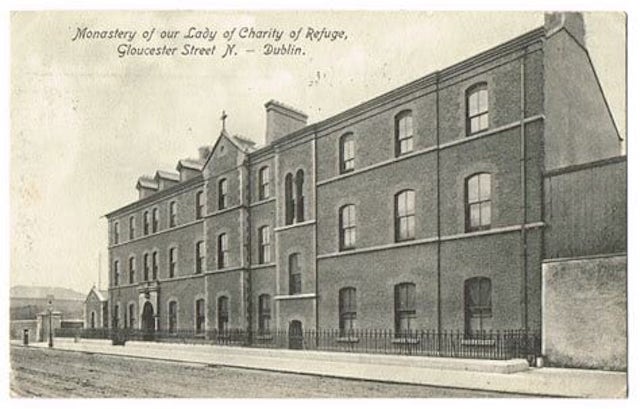The earliest parts of the current convent date from 1868 while it was operated by the Sisters of Mercy. After the Sisters of Charity took over the running of the site in 1887, there were several phases of expansion and building, which took the complex to its largest physical extent the mind-1960s [see our depiction below].
The convent building facing onto Sean MacDermott St is a handsome example of Victorian architecture, belying the dark nature of what went on deeper within the complex, and the difficult memories the Magdalene Women recall.
“I could tell you every top and bottom to the place…I could. Because when you walk into the convent you took a left, the door was there, then the door was into the women’s…the wom…the Magdalene Laundry into the convent part…and then you’d walk down…the kitchen was here…the pantry and…not the kitchen, the pantry and the dining room was there…then you walk…the chapel was there…no sorry, the little shop was there, then the chapel.
Then you walk down…the door to the yard was to the left…the door facing you at the end was the baths. There were three baths each side and that’s where you bathed yourself. But it was…I think six got…got the one bath…out of the one bath, so everyone would be fighting to get on queue first.”
O’Donnell, K., S. Pembroke and C. McGettrick. (2013) “Oral History of Martina Keogh”. Magdalene Institutions: Recording an Oral and Archival History.
Government of Ireland Collaborative Research Project, Irish Research Council, pp.33- 34.
“And (pause) we knocked on the door and she didn’t come in with me…was just taken in on my own……and it was a big creaky door, I’ll always remember it I can still hear the creak of the door, you know, and the door creaked and I turned around and she was gone.
…And they just took me into this room, and there was bars on the windows and there was a big long table…and a woman that was there and she interviewed me.
…She was…she was a social worker, yeah Áine, [pseudonym] can’t remember her surname but Áine was her name anyway and she interviewed me –she gave me a cup of tea and a sandwich…”
O’Donnell, K., S. Pembroke and C. McGettrick. (2013) “Oral History of Lucy”. Magdalene Institutions: Recording an Oral and Archival History.
Government of Ireland Collaborative Research Project, Irish Research Council, pp.8-9.

